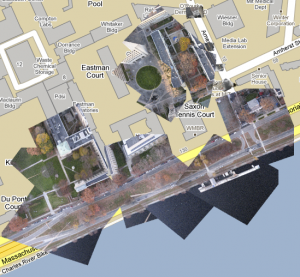Crossposted from Mondoweiss:
A recent post by Adam Horowitz asked what it will take for liberal Zionists to come around and support a boycott. My mind was changed by going to Israel on a Birthright trip and seeing firsthand the effects of the wall and checkpoints. However, I doubt that a full scale boycott of Israel will catch on in the American Jewish community. My recent project, the Boycott Toolkit, enables an open discussion of what exactly a boycott of the occupation should involve, lets users choose their own level of involvement, and lists concrete steps for action.
I was brought up in a religiously conservative but politically liberal Jewish community. While I was aware of and interested in politics, I didn’t consider myself an activist. Like most American Jews, I was aware of the ongoing peace process and lamented the inability of both sides to resolve their differences. A trip to Israel and the West Bank shattered my preconception of the two parties as equal antagonists, and convinced me to become more politically active and outspoken.
I joined a Taglit-Birthright trip in the summer of 2007 after graduating from college. Along with a group of twenty other young American Jews, I went to Israel for the first time and we did all the things that are supposed to connect us to our cultural and religious heritage. We met soldiers, visited Yad Vashem and cried at the Wailing Wall. We climbed Masada at dawn and surveyed the beautiful land that was once promised to our people, and was now ours.
However, while walking through the Old City of Jerusalem, or driving along highways to the Dead Sea, I could see that not all was well in this beautiful land. From a vantage point atop the ancient stone walls, a new concrete wall snakes across the landscape, and settlements stand out starkly on hilltops. Our bus was protected by an armed guard at all times, and he warned us sternly not to venture into Palestinian territory. Danger awaited there, kidnapping or lynching was possible, hatred and discrimination a certainty. He could not have been more wrong.
After the planned activities of the trip were over, we were released from the protection of the tour guides and guards. I returned to Jerusalem with two friends and took a bus to the Bethlehem checkpoint. We approached the monstrous concrete and steel gates with trepidation and entered the maw of the security zone. With our American passports, we were waved through by bored looking young women, really girls no older than I was, but who were surrounded by thick glass and armed with automatic weapons. The Palestinians were subject to more stringent checking, including a biometric scan of the veins in their hands. When I put my hand in the scanner, the guard gave me a withering look, as if it should be clear that I wasn’t subject to the same rules as everyone else in line. This sort of racial profiling may be effective, but it made my stomach churn.
Leaving the checkpoint, we entered a different world. While the Jerusalem side has a proper bus turnaround, in Bethlehem the road dead-ends into the wall and a throng of taxi drivers stand waiting for business. We were approached by a man with a yellow Mercedes, a baseball cap, and large weary eyes. Communicating through his broken English and our worse Arabic we negotiated a tour of the town, learning about its millennia of history and how it had changed since the wall cut it off from Jerusalem. We passed dozens of shuttered businesses and were taken to a dusty souvenir store that opened just for us. I bought ornaments I didn’t need to show my gratitude.
We only spent a few hours in Bethlehem that first time, and were relieved when we crossed the checkpoint back to Jerusalem. We would never see the city the same way again, knowing that an entirely different world lay on the other side of the wall. I have since returned to Israel and the West Bank many times, but crossing checkpoints still gives me the sense that I am crossing a land divided against itself, and that a great injustice is being done in my name.
Returning to the United States, I began graduate study at the MIT Media Lab with the Center for Future Civic Media. Research here is focused on building online tools for organizing real-world communities, and I set out to apply this knowledge to my community of interest: American Jews. I have released three projects that speak to this audience, which grew progressively more action-oriented.
In January 2009 I created VirtualGaza, a space for Gazans to break the information blockade by telling their own stories without a media filter. I spent the following summer meeting with Israeli and Palestinian activists in the West Bank. GroundTruth aggregates geographic information, the path of the wall and the green line, the location of Palestinian neighborhoods and Israeli settlements, the hundreds of checkpoints that disrupt traffic, and displays it in an interface familiar to users of Google Maps. Most of this information is published there for the first time in a reusable and open format. This project provides a local geographic context that is crucial to understanding the reality on the ground.
For my masters thesis, I am building an application to organize collective economic action, inspired by the BDS movement and the concept of smart sanctions. While a wholesale boycott of Israel can engender hostile feelings in even liberal American Jews, the Boycott Toolkit provides detailed information on specific companies and their relationship to the conflict. It asks users to take either positive or negative action by buying or boycotting products, and is open for community contributions. Building upon work by WhoProfits and Gush Shalom, the Boycott Toolkit already includes information on companies that are based in the settlements and industrial zones, vineyards in the occupied Golan Heights, and Palestinian products that support peaceful development. Stores that sell these products are listed and mapped, so consumers can alter their economic behavior to match their politics.
If you see products you recognize, please add stores in your area that sell them, so that we can track our impact in our own local communities. If you have other information about corporate complicity in the occupation, please add it so we can all benefit from your research. I know that these projects by themselves will not resolve the conflict. But if we can change the minds of other Jews like myself, who are vaguely aware of the issues but feel powerless to do anything about it, all our small actions taken together can bring us closer to peace.
Josh Levinger is a graduate student and researcher at the Center for Future Civic Media at MIT, where his work lies at the intersection of technology and politics.

 City of the Dead
City of the Dead